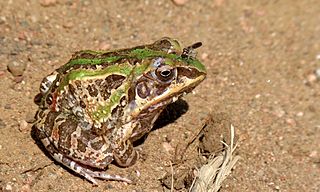
Cardioglossa is a genus of frogs in the family Arthroleptidae known as long-fingered frogs. They are native to western and central Africa, with the greatest species richness in Cameroon. They are found near streams in lowland and mountain forests, but also occur in other highland habitats near streams at up to 2,700 m (8,900 ft) in altitude. These are small frogs with a snout–to-vent length of 2 to 4 cm (0.8–1.6 in). Some of the more localized species are threatened.

Hildebrandtia is a genus of frogs in the family Ptychadenidae. They are distributed in tropical and subtropical Sub-Saharan Africa. The common name of this genus is Hildebrandt's burrowing frogs or ornate frogs. The genus name honours Johann Maria Hildebrandt, a German botanist and explorer.

Leptopelis is a genus of frogs in the family Arthroleptidae. They are found throughout Sub-Saharan Africa, excluding Madagascar. It is placed in monotypic subfamily Leptopelinae, although this subfamily is not always recognized. They have a number of common names, including forest treefrogs, tree frogs, leaf-frogs, and big-eyed frogs.
Cardioglossa melanogaster is a species of frog in the family Arthroleptidae. It is found in the mountains of western Cameroon and eastern Nigeria. Common name Amiet's long-fingered frog has been coined for it.
Phytotriades is a genus of tree frogs in the family Hylidae. As currently delimited, the genus is monotypic and contains Phytotriades auratus, commonly known as the golden tree frog, bromeliad-dwelling treefrog, El Tucuche golden tree frog, or Trinidad heart-tongued frog.

Acanthixalus sonjae is a species of frog in the family Hyperoliidae. It is found in south-western Ivory Coast and in south-western Ghana, and possibly in adjacent Liberia.

Acanthixalus spinosus is a species of frog in the family Hyperoliidae, the sedge and bush frogs. It is native to Africa, where it can be found in southeastern Nigeria and south- and eastward to Cameroon, Gabon, the Democratic Republic of the Congo, and the Republic of the Congo. It is also presumed to occur in the intervening/adjacent countries of Angola, Equatorial Guinea, and the Central African Republic. Common name African wart frog has been coined for this species.
Callixalus is a genus frogs in the family Hyperoliidae. It is monotypic, being represented by a single species, Callixalus pictus. It is found in the eastern Democratic Republic of the Congo and western Rwanda. It is sometimes known as the African painted frog.

Hyperolius concolor, also known as the variable reed frog or Hallowell's sedge frog, is a species of frog in the family Hyperoliidae. It occurs in West and Middle Africa.
Hyperolius sylvaticus is a species of frog in the family Hyperoliidae. It is found in southern Ivory Coast, Ghana, Togo, Nigeria, and western Cameroon, with a gap in Benin. It is also likely to occur in Liberia. Common name Bobiri reed frog has been coined for this species.
Hyperolius wermuthi is a species of frog in the family Hyperoliidae. It is found in Ivory Coast, southern Guinea, and Liberia. The correct name for this species is likely Hyperolius soror. It is so similar to Hyperolius fusciventris that it has likely been overlooked elsewhere in West Africa. Common name Wermuth's reed frog has been coined for this species.
Kassina schioetzi is a species of frogs in the family Hyperoliidae. It is found in Ivory Coast and extreme southeastern Guinea. Its range probably extends into northwestern Ghana.

Leptopelis aubryi, also known as the Aubry's tree frog and Gaboon forest treefrog, is a species of frog in the family Arthroleptidae. It is found in southeastern Nigeria, Cameroon, Central African Republic, Equatorial Guinea, Gabon, Republic of the Congo, western and northern Democratic Republic of the Congo, and Angola.

Leptopelis millsoni is a species of frog in the family Arthroleptidae. It is found in southeastern Nigeria, Cameroon, the Central African Republic, Equatorial Guinea, Gabon, the Republic of the Congo, the eastern Democratic Republic of the Congo, and northwestern Angola. Common names Niger forest treefrog and Millson's Tree Frog have been coined for it. There is a need of taxonomic revision of this taxon.
The Tai forest tree frog, Leptopelis occidentalis, is a species of frog in the family Arthroleptidae. It is found in Liberia, southern Ivory Coast, and Ghana. Records from Nigeria are controversial and may refer to other species, possibly Leptopelis boulengeri.

Petropedetes cameronensis, sometimes known as the Cameroon water frog, is a species of frog in the family Petropedetidae. It is found in southeastern Nigeria, southwestern Cameroon, and on the island of Bioko. It is the type species of the genus Petropedetes.
Petropedetes perreti is a species of frog in the family Petropedetidae. It is endemic to Cameroon. It is known from the southern slopes of the Bamiléké Plateau, Mount Manengouba, and Mount Nlonako. Common name Perret's water frog has been coined for it.

Phrynobatrachus is a genus of Sub-Saharan frogs that form the monogeneric family Phrynobatrachidae. Their common name is puddle frogs, dwarf puddle frogs, African puddle frogs, or African river frogs. The common name, puddle frog, refers to the fact that many species breed in temporary waterbodies such as puddles.

Leptopelis spiritusnoctis is a species of frog in the family Arthroleptidae. It is found in West Africa from Guinea to the Niger Delta in Nigeria, the intervening countries being Sierra Leone, Liberia, Ivory Coast, Ghana, Togo, and Benin. This species was previously known as Leptopelis hyloides, but that name is actually a junior synonym of Leptopelis viridis.

Odontobatrachus is a genus of frogs comprising the family Odontobatrachidae. In a 2014 research project Barej, Rödel, Loader & Schmitz separated the genus from the established genus Petropedetes and separated the new family from the established family Petropedetidae.










